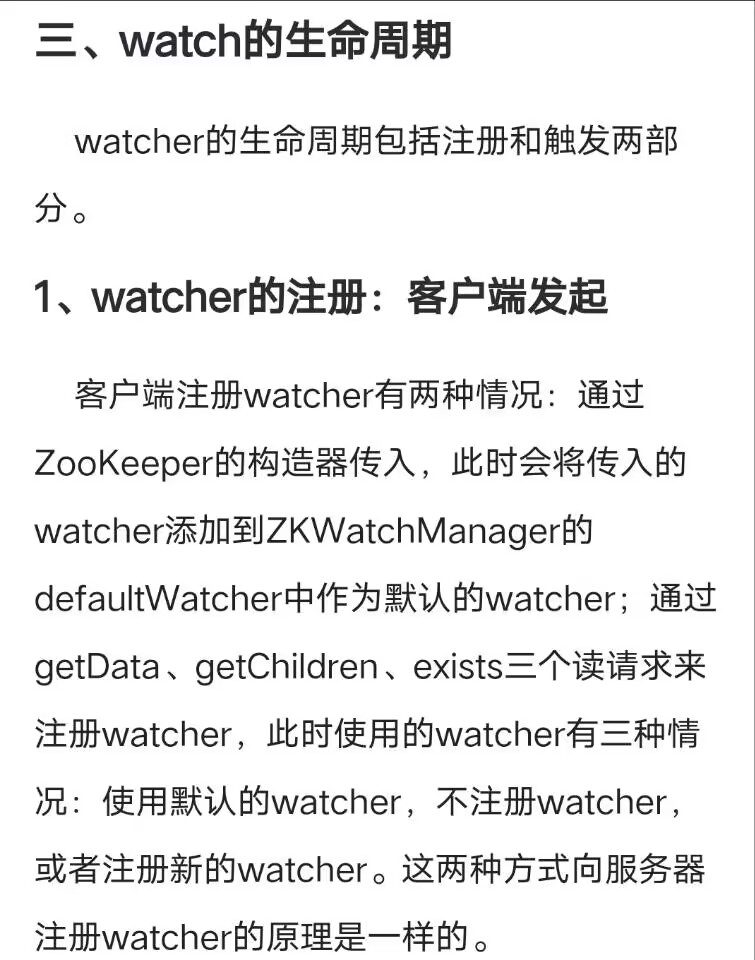Zookeeper的Java API操作

Zookeeper的Java API操作
-
- 一、先启动Zookeeper集群
- 二、IDEA 环境搭建
- 三、创建子节点
- 四、获取子节点并监听节点变化
- 五、判断 Znode 是否存在
- 六、Watcher工作流程
一、先启动Zookeeper集群
二、IDEA 环境搭建
1.创建一个Maven工程:ZookeeperProject
2.在pom.xml文件添加如下内容:
<dependencies><dependency><groupId>junit</groupId><artifactId>junit</artifactId><version>RELEASE</version></dependency><dependency><groupId>org.apache.logging.log4j</groupId><artifactId>log4j-core</artifactId><version>2.8.2</version></dependency><dependency><groupId>org.apache.zookeeper</groupId><artifactId>zookeeper</artifactId><version>3.5.7</version></dependency>
</dependencies>
3.拷贝log4j.properties文件到项目根目录
需要在项目的 src/main/resources 目录下,新建一个文件,命名为“log4j.properties”,在文件中填入:
log4j.rootLogger=INFO, stdout
log4j.appender.stdout=org.apache.log4j.ConsoleAppender
log4j.appender.stdout.layout=org.apache.log4j.PatternLayout
log4j.appender.stdout.layout.ConversionPattern=%d %p [%c] - %m%n
log4j.appender.logfile=org.apache.log4j.FileAppender
log4j.appender.logfile.File=target/spring.log
log4j.appender.logfile.layout=org.apache.log4j.PatternLayout
log4j.appender.logfile.layout.ConversionPattern=%d %p [%c] - %m%n
三、创建子节点
package com.hyj.zk;import org.apache.zookeeper.*;
import org.junit.After;
import org.junit.Before;
import org.junit.Test;import java.io.IOException;
import java.util.List;public class CreateZnode {//注意:逗号前后不能有空格 指定Zookeeper服务器列表private static String connectString="hadoop102:2181,hadoop103:2181,hadoop104:2181";/* sessionTimeout指会话的超时时间,是一个以“毫秒”为单位的整型值。在ZooKeeper中有会话的概念,在一个会话周期内,ZooKeeper客户端和服务端之间会通过心跳检测机制来维持会话的有效性,一旦在sessionTimeout时间内没有进行有效的心跳检测,会话就会失效。*/private static int sessionTimeout=100000;private ZooKeeper zkClient=null;@Beforepublic void init() throws IOException {//创建一个Zookeeper实例来连接Zookeeper服务器 Watcher会话监听器,服务端将会触发监听zkClient=new ZooKeeper(connectString, sessionTimeout, new Watcher() {@Override //收到事件通知后的回调函数(用户的业务逻辑)public void process(WatchedEvent watchedEvent) {}});}@Test //创建子节点public void create() throws InterruptedException, KeeperException {/* 参数 1:要创建的节点的路径; 参数 2:节点数据(一个字节数组) ;参数 3:节点权限 ;ZooDefs.Ids.OPEN_ACL_UNSAFE表示以后对这个节点的任何操作都不受权限控制参数 4:节点的类型 持久无序号节点PERSISTENT 持久带序号节点 PERSISTENT_SEQUENTIAL (persistent_sequential)短暂无序号节点EPHEMERAL 短暂带序号节点 EPHEMERAL_SEQUENTIAL (ephemeral_sequential)*/String s = zkClient.create("/sanguo/xiyouji", "sunwu".getBytes(), ZooDefs.Ids.OPEN_ACL_UNSAFE, CreateMode.PERSISTENT);}@Afterpublic void close() throws InterruptedException {zkClient.close();}
}
从ZookKeeper系列:watch机制截的一张图
监听的事件类型有:
- None 客户端连接状态发生改变的时候,会收到None事件通知(如连接成功,连接失败,session会话过期等)
- NodeCreated 节点被创建
- NodeDeleted 节点被删除
- NodeDataChanged 节点数据被修改
- NodeChildrenChanged 子节点被创建或删除
四、获取子节点并监听节点变化
package com.hyj.zk;import org.apache.zookeeper.KeeperException;
import org.apache.zookeeper.WatchedEvent;
import org.apache.zookeeper.Watcher;
import org.apache.zookeeper.ZooKeeper;
import org.junit.After;
import org.junit.Before;
import org.junit.Test;import java.io.IOException;
import java.util.List;public class GetChildren {//注意:逗号前后不能有空格 指定Zookeeper服务器列表private static String connectString="hadoop102:2181,hadoop103:2181,hadoop104:2181";/* sessionTimeout指会话的超时时间,是一个以“毫秒”为单位的整型值。在ZooKeeper中有会话的概念,在一个会话周期内,ZooKeeper客户端和服务端之间会通过心跳检测机制来维持会话的有效性,一旦在sessionTimeout时间内没有进行有效的心跳检测,会话就会失效。*/private static int sessionTimeout=100000;private ZooKeeper zkClient=null;@Beforepublic void init() throws IOException {//创建一个Zookeeper实例来连接Zookeeper服务器 Watcher会话监听器,服务端将会触发监听zkClient=new ZooKeeper(connectString, sessionTimeout, new Watcher() {@Override //收到事件通知后的回调函数(用户的业务逻辑)public void process(WatchedEvent watchedEvent) {if(watchedEvent.getType() == Event.EventType.None){if(watchedEvent.getState() == Event.KeeperState.SyncConnected){System.out.println("Zookeeper连接成功!!!");}else if(watchedEvent.getState() == Event.KeeperState.Disconnected){System.out.println("客户端和服务器的连接断开!!!");}else if (watchedEvent.getState() == Event.KeeperState.Expired){System.out.println("session会话过期!!!");}}else{System.out.println(watchedEvent.getType() + "--" + watchedEvent.getPath());try {//再次监听(注册一次,监听一次)List<String> children = zkClient.getChildren("/", true); //false表示不监听,true表示使用默认的watcherfor (String child : children) {System.out.println(child);}} catch (KeeperException | InterruptedException e) {e.printStackTrace();}}}});}@Test //获取子节点并监听节点路径变化public void getChildren() throws InterruptedException, KeeperException {// 参数1: 表示监听的节点 参数2: true表示监听 ,false表示不监听List<String> children = zkClient.getChildren("/", true); //使用默认的watcherfor (String child : children) {System.out.println(child);}//延时阻塞Thread.sleep(Long.MAX_VALUE);}@Test //获取子节点不监听节点路径变化public void getChildren2() throws InterruptedException, KeeperException {// 参数1: 表示监听的节点 参数2: true表示监听 ,false表示不监听List<String> children = zkClient.getChildren("/", false); //不注册watcherfor (String child : children) {System.out.println(child);}}@Test //获取子节点并监听节点路径变化public void getChildren3() throws InterruptedException, KeeperException {// 参数1: 表示监听的节点 参数2: true表示监听 ,false表示不监听List<String> children = zkClient.getChildren("/", new Watcher() { //注册新的watcher@Override //收到事件通知后的回调函数(用户的业务逻辑)public void process(WatchedEvent watchedEvent) {System.out.println(watchedEvent.getType() + "------" + watchedEvent.getPath());try {List<String> children = zkClient.getChildren("/", false); //这里若是true它还是会使用默认的watcherfor (String child : children) {System.out.println(child);}} catch (KeeperException | InterruptedException e) {e.printStackTrace();}}});for (String child : children) {System.out.println(child);}//延时阻塞Thread.sleep(Long.MAX_VALUE);}@Afterpublic void close() throws InterruptedException {zkClient.close();}
}五、判断 Znode 是否存在
package com.hyj.zk;import org.apache.zookeeper.*;
import org.apache.zookeeper.data.Stat;
import org.junit.After;
import org.junit.Before;
import org.junit.Test;import java.io.IOException;
import java.util.List;public class IsExistNode {//注意:逗号前后不能有空格 指定Zookeeper服务器列表private static String connectString = "hadoop102:2181,hadoop103:2181,hadoop104:2181";/* sessionTimeout指会话的超时时间,是一个以“毫秒”为单位的整型值。在ZooKeeper中有会话的概念,在一个会话周期内,ZooKeeper客户端和服务端之间会通过心跳检测机制来维持会话的有效性,一旦在sessionTimeout时间内没有进行有效的心跳检测,会话就会失效。*/private static int sessionTimeout = 100000;private ZooKeeper zkClient = null;@Beforepublic void init() throws IOException {//创建一个Zookeeper实例来连接Zookeeper服务器 Watcher会话监听器,服务端将会触发监听zkClient = new ZooKeeper(connectString, sessionTimeout, new Watcher() {@Override //收到事件通知后的回调函数(用户的业务逻辑)public void process(WatchedEvent watchedEvent) {if (watchedEvent.getType() != Event.EventType.None) {System.out.println(watchedEvent.getType() + "--" + watchedEvent.getPath());try {List<String> children = zkClient.getChildren("/", false); //false表示不监听,true表示使用默认的watcherfor (String child : children) {System.out.println(child);}} catch (KeeperException | InterruptedException e) {e.printStackTrace();}}}});}@Testpublic void exist() throws InterruptedException, KeeperException {// 参数1: 表示要判断的节点 参数2: true表示监听 ,false表示不监听Stat stat = zkClient.exists("/sanguo", false); //不注册watcherSystem.out.println(stat == null ? "not exist" : "exist");}@Testpublic void exist2() throws InterruptedException, KeeperException {// 参数1: 表示要判断的节点 参数2: true表示监听此节点变化 ,false表示不监听Stat stat = zkClient.exists("/sanguo", true); //使用默认的watcherSystem.out.println(stat == null ? "not exist" : "exist");//延时阻塞Thread.sleep(Long.MAX_VALUE);}@Testpublic void exist3() throws InterruptedException, KeeperException {// 参数1: 表示要判断的节点 参数2: true表示监听此节点变化 ,false表示不监听Stat stat = zkClient.exists("/sanguo", new Watcher() {@Override //收到事件通知后的回调函数(用户的业务逻辑)public void process(WatchedEvent watchedEvent) { //注册新的watcherSystem.out.println(watchedEvent.getType() + "--" + watchedEvent.getPath());try {List<String> children = zkClient.getChildren("/", false); //false表示不监听,true表示使用默认的watcherfor (String child : children) {System.out.println(child);}} catch (KeeperException | InterruptedException e) {e.printStackTrace();}}});System.out.println(stat == null ? "not exist" : "exist");//延时阻塞Thread.sleep(Long.MAX_VALUE);}@Afterpublic void close() throws InterruptedException {zkClient.close();}
}六、Watcher工作流程
Client 向 Zookeeper 服务端注册一个 Watcher ,同时将Watcher对象存储在客户端的 WatcherManager 中。当Zookeeper 服务端的一些指定事件触发了 Watcher 事件时,就会向客户端发送事件通知,客户端就会从WatcherManager 中取出对应的 Watcher 进行回调。
Watcher工作机制分为三个过程:
-
客户端注册Watcher
-
服务端处理Watcher
-
客户端回调Watcher


